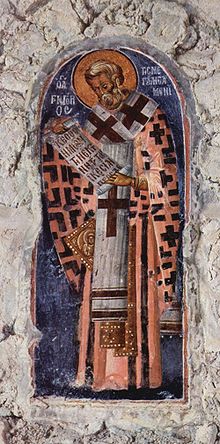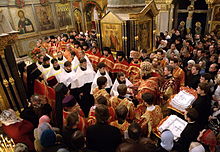Phelonion
The Phelonion ( Greek φελώνιον, φαιλόνιον, φαινόλιον, φαιλόνης, φελόνης and similar cloak ) is a liturgical garment of the priests of Orthodox , Oriental-Orthodox and Catholic Eastern Churches . Until the general introduction of the jacket , the phelonion was also the usual liturgical upper garment of Byzantine bishops.
Appearance and use
The Phelonion was originally, like its western church counterpart, the chasuble , a kind of poncho . It's a large piece of cloth with a round hole for the head. It is worn as the top piece of clothing and hangs on the back to the lower legs, but on the front only to the hips so that the priest can move hands and arms more easily.
There are two different cuts of the Phelonia in the Byzantine Rite. The Byzantine-Greek Phelonion is tailored so that it is only hung over the shoulders, while the Russian Phelonion has a high stiffened collar on the back that covers the back of the head. There is also a shortened Phelonion, which is worn by lecturers while the tonsure is being cut. This "little Phelonion" is still worn today by altar servers of the Old Believer churches.
The Phelonion with priests is not limited to the Eucharistic liturgy , but is used in many priestly functions.
particularities
Sometimes a bishop wishes to celebrate the Holy Liturgy “as a priest” (that is, without the special rites and prayers of the Eastern Church's pontifical liturgies). Today he is dressed in a phelonion instead of the episcopal jacket , but wears a small omophorion around the neck and the epigonation on the side as a sign of his higher dignity .
Bishops and archpriests wore or mostly wear the polystavrion , a richly decorated phelonion with elaborately embroidered, multi-layered crosses.
In Oriental Orthodox churches , the Phelonion is often only attached to the neck and is more open towards the front than its Byzantine counterpart. In this case, it resembles the western cope .
The different names of the Phelonion are: Phanolion ( Coptic ), Paynā ( Assyrian ), Phayno ( Syriac Orthodox ), Šurdzar ( Armenian ) and Kāppā ( Ethiopian ).
While mooring, the priest says the prayer: “Let your priests clothe themselves in righteousness, that your saints may rejoice, now and forever, and into the ages of ages. Amen."
Web links
Individual references and sources
- ↑ L. Clugnet: Dictionnaire grec-français des noms liturgiques en usage dans l'église grecque . Picard, Paris 1895, p. 161.
- ↑ The Holy Liturgy (PDF file)



